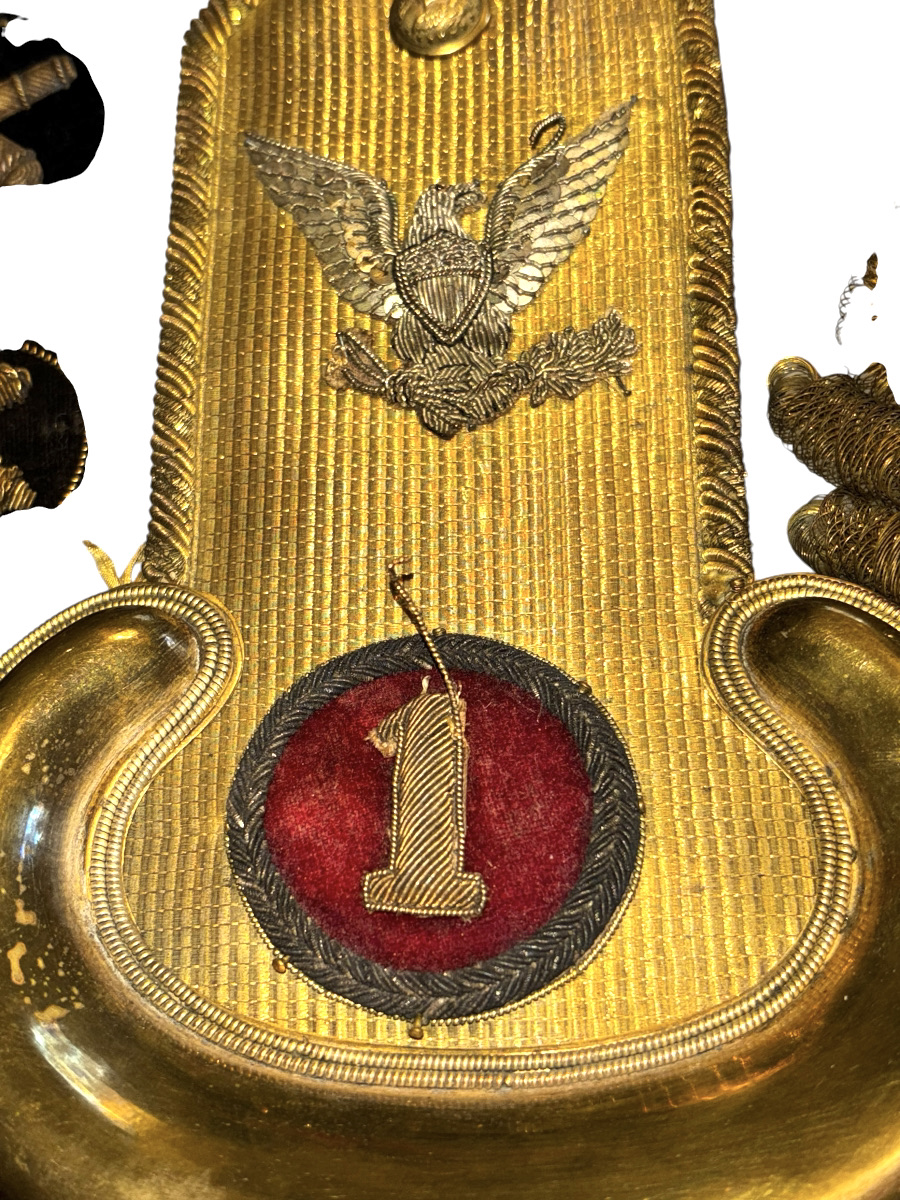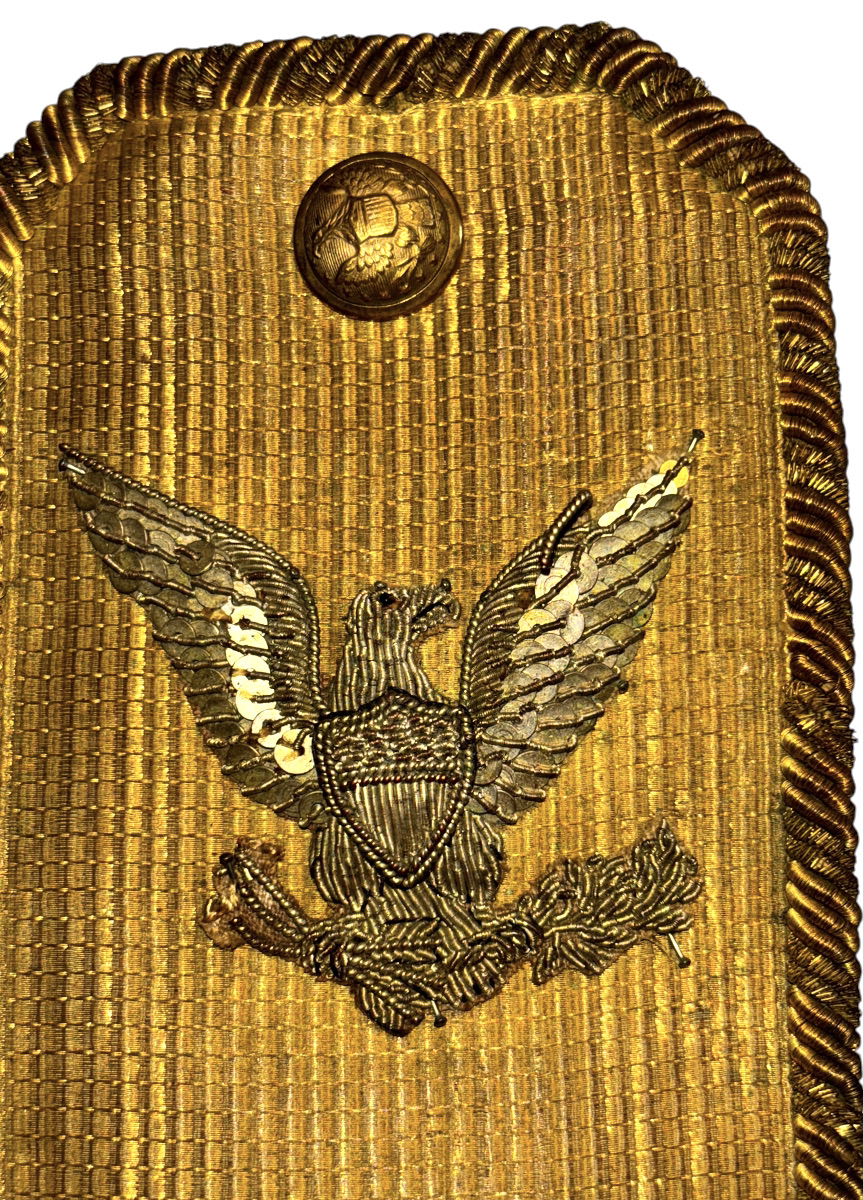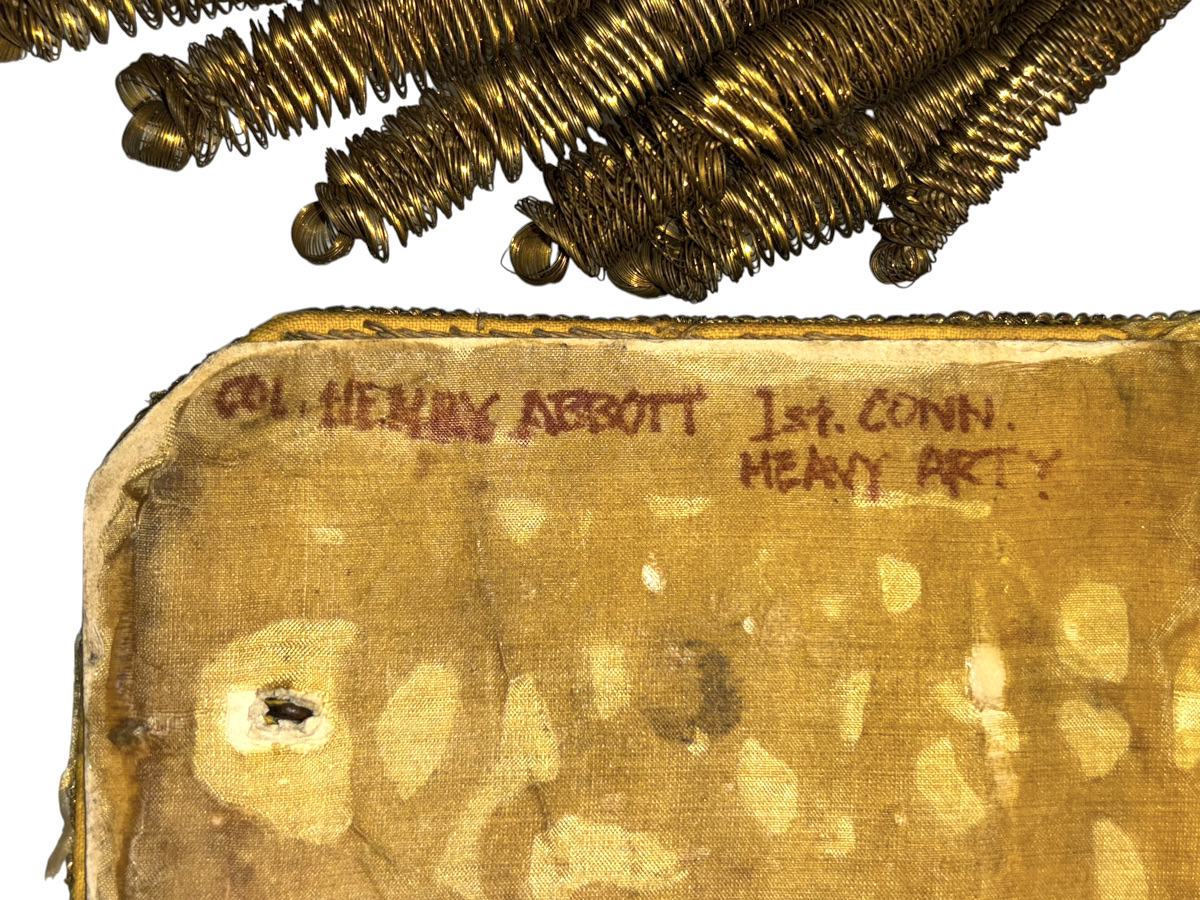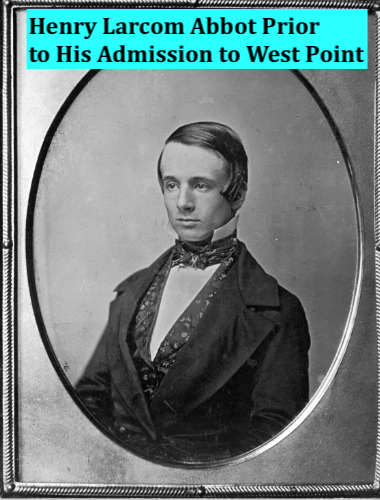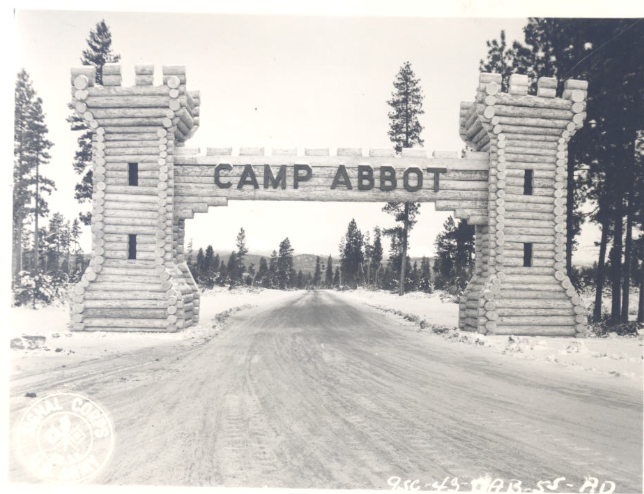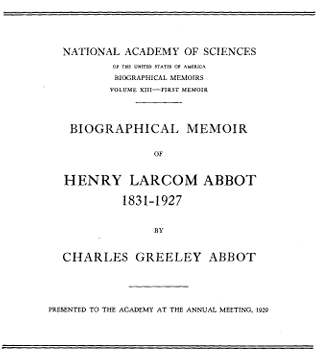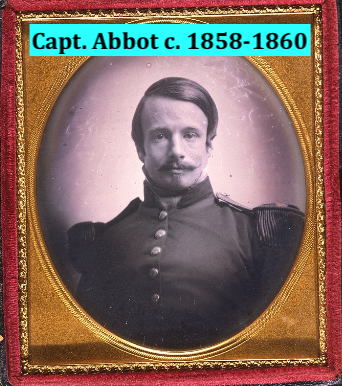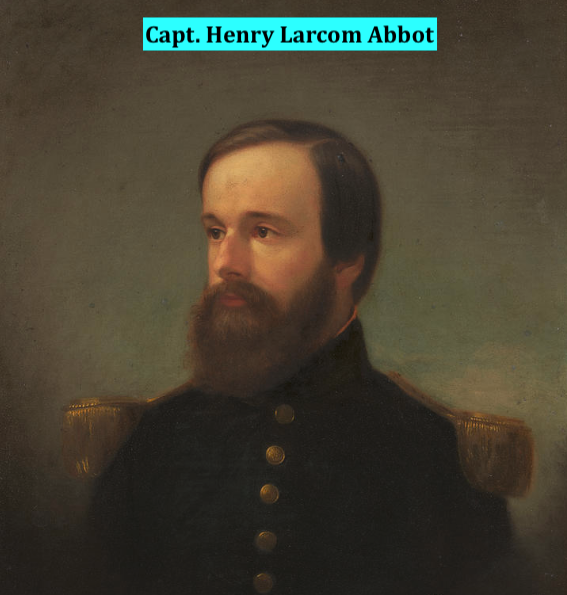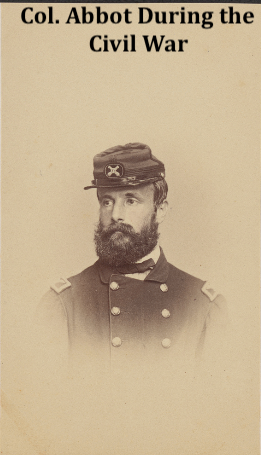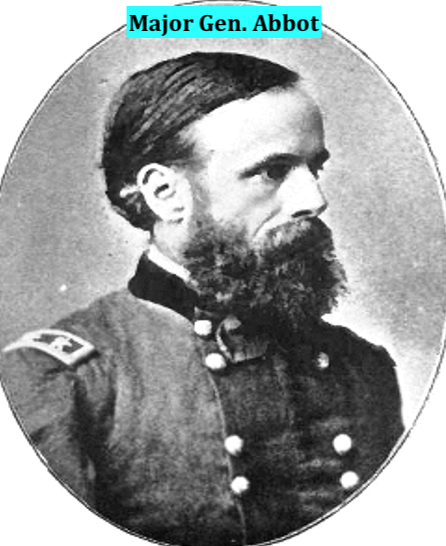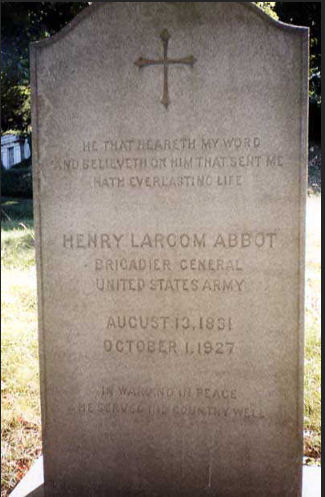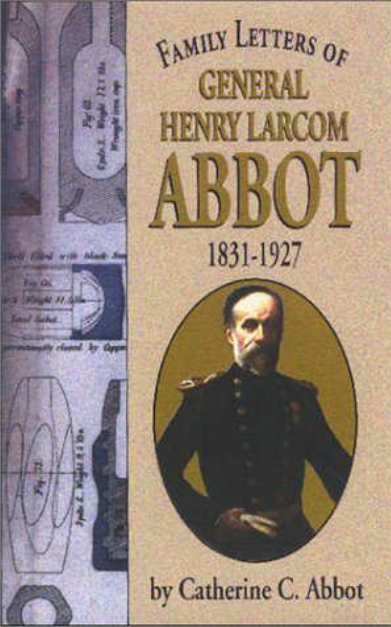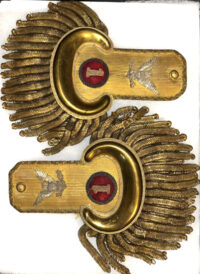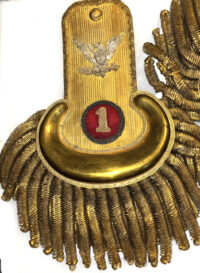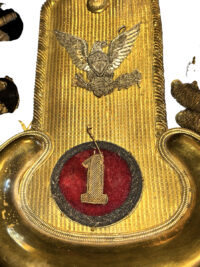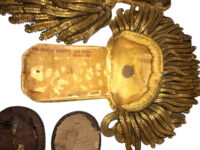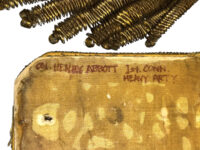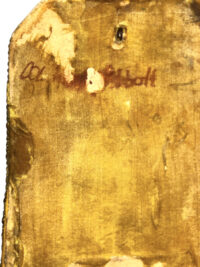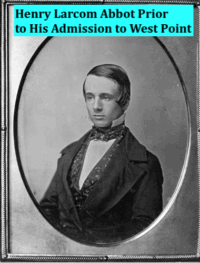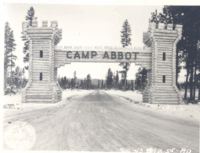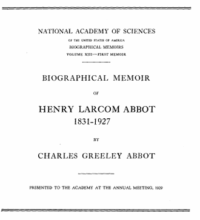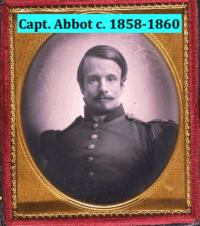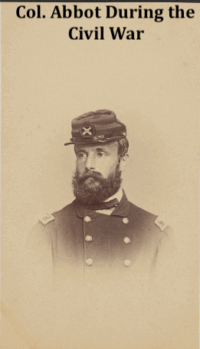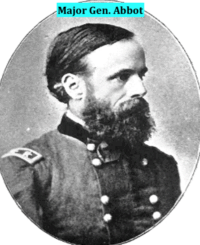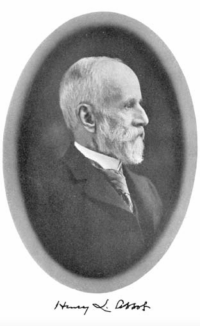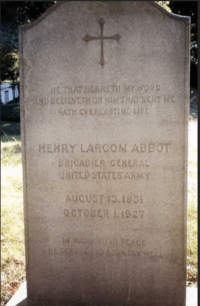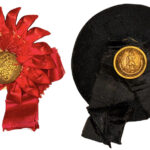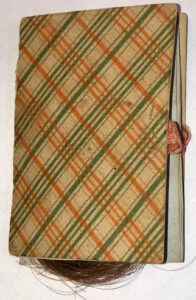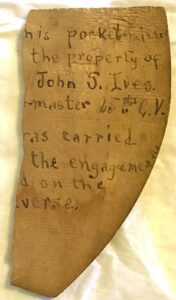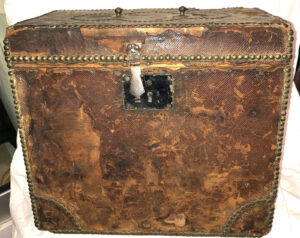Civil War Period Dress Epaulettes of Col. Henry Larcom Abbot(t) of the 1st Connecticut Heavy Artillery
SOLD
Civil War Period Dress Epaulettes of Col. Henry Larcom Abbot(t) of the 1st Connecticut Heavy Artillery – Henry Larcom Abbot (August 13, 1831 – October 1, 1927) was a military engineer and career officer in the U.S. Army He served in the Union Army during the Civil War and was appointed brevet General of volunteers for his contributions in engineering and artillery. In 1866 he received additional brevet appointments as Major General of volunteers and Brigadier General in the Regular Army. He conducted several scientific studies of the Mississippi River with captain, later Major General Andrew A. Humphreys. After his retirement, Abbot served as a consultant for the locks on the Panama Canal. He was elected a Fellow of the American Academy of Arts and Sciences in 1863. A West Point graduate, in the same class as JEB Stuart and George B. McClellan, Abbot would have a very distinguished career in the U.S. Army prior to his service during the Civil War and after. His lengthy career and important military, engineering and scientific achievements are enumerated in great detail in the research we compiled, listed below. Included with these epaulettes is a small, paperback book of Gen. Abbot’s letters, compiled and edited by a direct descendant of Gen. Abbot, Catherine C. Abbot.
Col. Abbot’s dress epaulettes are of superior quality, constructed of gilded and silvered bullion; his artillery service is indicated by a circular disk, with a bullion regimental number “1” on a red velvet field, on each of the epaulettes, as well as a silver bullion Colonel’s eagle, on each epaulette; a staff officer cuff button is affixed to each distal end of the epaulettes. The underside of the epaulettes is padded and covered with gold-yellow silk that evidence wear and some minor staining; one of the strands of bullion wire surrounding a regimentally numbered disk has loosened, but is all there. The epaulettes remain in overall excellent condition. On the underside of one of the epaulettes is inscribed, in red ink, the following:
“COL. HENRY ABBOTT 1st. CONN.
HEAVY ARTY “
On the underside of the other epaulette is inked, in red:
“COL. ??? ABBOTT “
Henry Larcom Abbott
Residence was not listed; a 31-year-old Army Officer.
Enlisted on 1/19/1863 as a Colonel.
On 1/19/1863, he was commissioned into Field & Staff Connecticut 1st Heavy Artillery.
He was Mustered Out on 9/25/1865 at Washington, DC
Promotions:
- Brig-General 8/1/1864 by Brevet
- Brig-General 3/13/1865 by Brevet
- Major-Gen 3/13/1865 by Brevet
Born 8/13/1831 in Beverly, MA
Died 10/1/1927 in Cambridge, MA
Buried: Mount Auburn Cemetery, Cambridge, MA
1st CT Heavy Artillery
Organized: From 4th CT Inf on 5/23/1861
Mustered out: 9/25/1865
CONNECTICUT FIRST REGIMENT HEAVY ARTILLERY. (Three Years.) WRITTEN BY BVT. BRIG.-GEN. HENRY L. ABBOT, LATE COLONEL FIRST C. V. HEAVY ARTILLERY. THE First Connecticut Artillery, originally the Fourth Connecticut Volunteers, Infantry, was raised in the enthusiastic response to the first call (April 15, 1861) of President Lincoln for 75,000 men for three months. Its companies gathered at Hartford, expecting to be included among those accepted, but the State quota had been already more than filled. The call of May 3, 1861, for 42,000 men, required that enlistments should be for three years, and the regiment, after going into camp at Hartford, was re-organized for this period, and was mustered into the United States service by Colonel Loomis on May 22d and 23d. It is believed to have been the first three-years regiment of any State ready for field service. The regiment was composed of men from all parts of Connecticut, but the companies were credited to towns as follows: Company A, Hartford; Company B, Ansonia and Derby; Company C, Suffield, Windsor Locks, and vicinity; Company D, New London; Company E, New Haven; Company F, New Haven; Company G, Middletown; Company H, Middletown; Company I, Wolcottville; Company K, Hartford; subsequently Company L was raised and credited to Hartford, and Company M to Bridgeport. On June 10th the regiment left Hartford to join General Patterson’s command at Chambersburg, and on June 17th was there brigaded with the First Wisconsin and Eleventh Pennsylvania. On June 17th it moved to Hagerstown to perform guard duty. On July 4th the left wing was detached to Williamsport to hold the ford of the Potomac; on August 9th it was relieved and ordered to Frederick City. On August 17th the right wing joined, and the regiment soon went into camp at White Oak Springs, near the city. On September 6th it was ordered to report to General Banks at Darnestown, where it was brigaded with the 13th Massachusetts under General Hamilton. On September 9th Colonel Woodhouse resigned. Lieutenant- Colonel White was in command until September 26th, when Colonel Tyler joined. The regiment was ordered to Washington, beginning the march on October 2d, and while enroute changed the State gray uniform for the army blue. On October 7th it camped near the Capitol, and on October 9th crossed the Potomac and went into camp for the winter, finishing and garrisoning Forts Richardson, Scott, and Barnard. On January 2, 1862, its organization was changed to artillery, with an aggregate of 1,839 officers and enlisted men The new companies (L and M), with recruits for the rest of the regiment, arrived on March 15th. This winter was a very important one in its history. The most rigid discipline was enforced by Colonel Tyler, and his training in every soldierly duty laid the foundation, for that reputation which distinguished the First Connecticut Artillery during the rest of its term of service. Study of text books and drills in artillery and infantry tactics were unceasing. On April 3d the regiment embarked for the Peninsula, arriving on April 11th at Cheeseman’s Landing, near Yorktown, 1,400 strong. Here, with the Fifth New York, it was detailed to serve the siege train. The following was the assignment to batteries: Company B to No. 1 (two 200-pounder and five 100- pounder Parrotts); Companies A and H to No. 2 (five 43-inch ordnance guns and five 30-pounder Parrotts); Companies F and G to No. 4 (ten 13-inch mortars); Company C to No. 6 (six l0- inch mortars); Companies D and E to No. 9 (ten 10-inch mortars); and Company I to No. 10 (five 4 1/2-inch ordnance guns). Much difficult work was performed in placing these guns in position. Battery No. 1 fired 141 shots with effect on April 30th and May 1st, 2d, and 3d; and all the others were ready to open on May 4th, when Yorktown was evacuated. After re-embarking the material and leaving it in charge of Companies L and M, Colonel Tyler reported with ten companies to General Fitz-John Porter at White House on May 20th to serve as infantry. They were brigaded in Sykes’s Division of the Fifth Corps, and were employed in reconnoissances, in destroying the means of crossing the Pamunkey, and at Hanover C. H. In following Stuart’s cavalry raid in rear of the army they marched forty-two miles in thirty seven hours, leading the infantry column. On June 2d General McClellan ordered a detachment to be made from the regiment to supply deficiencies in the regular batteries. One hundred and eighty-nine privates were detailed, viz.: from Company A, 12; B, 31; C, 42; D, 20; E, 4; F, 29; G, 21; H, 8; and from I, 22. They performed active and creditable service during the Peninsular campaign, and rejoined their regiment after its close. On June 20th Colonel Tyler was ordered to bring up five 4 1/2-inch guns and five 30-pounder Parrotts. On June 24th they were in position near New Bridge, under Major Kellogg, served by Companies B, D, and F. On June 25th and 26th they fired effectively; and on the latter date were moved across the Chickahominy to Golding’s farm, where, re-inforced by two 10- pounder Whitworths served by Company I, they were heavily engaged on June 27th. On that night they were withdrawn; and, across White Oak Swamp, joined the rest of the train under Major Hemingway, 8-inch consisting of two 8-inch howitzers, two 10-pounder Whitworths, and nine other heavy guns, which had been in position near Seven Pines and in depot at Orchard Station. The united train was moved to Turkey Bend, and during the night of June 30th Companies B, D, F, I, and K placed with great difficulty five 4 1/2-inch ordnance guns, five 30-pounder Parrotts, two 8-inch howitzers, and two 10- pounder Whitworths in position on Malvern Hill. These guns were gallantly and effectively served in the great battle of July 1st, although, in addition to the fire of the enemy, the men suffered from a rear fire from our gunboats, by which four men of Company F were wounded, three mortally. During the following night the train was retired to Westover Landing. In the artillery attack upon Harrison’s Landing, on the night of August 1st, Companies A, H, and I replied promptly from five 30-pounder Parrotts and four 10-pounder Whitworths which had been placed in position on the river bank to repel an expected attack from ironclads. The services of the regiment during this campaign were highly commended by General McClellan in his official report Out of twenty-six heavy guns brought from Yorktown, twenty five arrived safely at Harrison’s Landing; only one howitzer, of which the carriage was injured, was abandoned. This was accomplished “with mule teams constantly breaking down, driven by frightened civilian teamsters who deserted whenever the fire became heavy; frequently teams had to be pressed into service to replace those which had been exhausted by the labor of drawing the guns, and sometimes for miles the guns were drawn by hand by the different companies of the regiment.” For this campaign the First Connecticut Artillery was authorized to place upon its colors: “Siege of Yorktown, Hanover C. H., Chickahominy, Gaines’ Mills, and Malvern.” On August 12th the regiment embarked for Alexandria, where it was distributed in the defenses from Fort Scott to Fort Ward inclusive. Here it remained (except Companies B and M) until the campaign of 1864. Colonel Tyler was promoted on November 29, 1862, and was succeeded by Colonel Abbot on February 27, 1863. Except when the depot of the Army of the Potomac at Alexandria was threatened by raiding parties in the Gettysburg campaign, this was a season of comparative inaction; advantage was taken of it to thoroughly practice the regiment in the use of all kinds of field and siege guns and mortars, and in infantry drill, including the School of the Brigade. When it again took the field it was inferior neither in discipline nor efficiency to any regular regiment in service. On December 5, 1862, Major Trumbull, with Company B, Captain Brooker, and Company M, Captain Pratt, was detached with seven 4 1/2-inch guns for duty at Fredericksburg. They fired 357 rounds in the battle of that month. Subsequently the companies joined the Artillery Reserve of the Army of the Potomac at Falmouth, equipped as light artillery batteries of four 4 1/2-inch siege guns. They followed the movements of the army during 1863, marching more than 500 miles. Company B was engaged at Fredericksburg in June, serving a 100-pounder Parrott, and at Wolf Run on November 30th. Company M was engaged at Fredericksburg in the battles of April, May, and June, at Kelley’s Ford on November 7th, and at Mine Run. The use of such heavy guns with a marching army was an experiment, but they were never allowed to fall behind. The companies rejoined the regiment in April, 1864. On April 20, 1864, Colonel Abbot was ordered by General Halleck to organize a large siege train upon a memorandum drawn up by General Hunt, Chief of Artillery of the Army of the Potomac. Captain Hatfield was detailed as its Ordnance Officer, and the material was essentially afloat by May l0th. At that date the regiment was ordered to report for temporary duty as infantry to General Butler, then advancing from Bermuda Hundred. It arrived on May 13th, 1,700 strong, and reinforced the Eighty-fifth Pennsylvania in holding the line against an expected attack from the direction of Petersburg. On May 16th the Army of the James fell back to the entrenchments, and the First Connecticut Artillery was placed in charge of its siege guns, seventeen in number. From that date until the arrival of the Army of the Potomac, about a month, a heavy artillery fire prevailed along the lines, the regiment firing twenty five tons (1,971 rounds). There were three sharp combats–on May 20th, when a demonstration was made upon the position; on June 2d, when Company L, Captain Pride, stationed in advanced redoubt Dutton, repulsed an assault of the Twenty-second South Carolina, killing its colonel and taking a lieutenant and twenty-two enlisted men prisoners; and on June 21st, when the Confederate rams engaged our James River fleet and land batteries. On May 23d an incident occurred illustrating the spirit which pervaded the regiment. Six soldiers returning from veteran volunteer furlough were passing Wilson’s Landing when an attack was made upon a small garrison there stationed. The boat landed and these men most gallantly served a l0-pounder Parrott, which had been abandoned, until the enemy was repulsed. Theirs was the only gun not silenced. On June 23d the regular train arrived from Washington, and the siege began in earnest. Space is lacking to adequately describe what, in many of the batteries, was for days at a time a continuous engagement. For details and especially for mention of individuals, reference is made to the reports of General Abbot in the annual reports of the Adjutant-General of Connecticut for the years 1865 and 1866; and for the professional results of the regimental experience, to Prof. Papers No. 14, Corps of Engineers, U. S. A. During these operations the siege train was organized as a separate brigade under Colonel Abbot, such additional troops as were needed being temporarily attached. The aggregate at times exceeded 3,500 men; the train contained 127 guns and seventy- three mortars; the line of batteries was seventeen miles long; over 1,200 tons of ammunition (63,940 rounds), hauled an average distance of seven miles by wagon, were fired during the siege. The depot, under command of Major Hatfield, was at Broadway Landing on the Appomattox River, where the needful wharves and some strong earth-works for defense were built. The guns not in use were kept afloat, and he was supplied with about twenty schooners and barges, a steam tug, and a permanent train of fifty Government wagons, often largely increased. The guns were moved by four light artillery teams of Company M, First Pennsylvania Artillery, attached to the depot. Ammunition was forwarded daily as needed, the amount being regulated by telegraph. For batteries serving on the lines of the Army of the Potomac, Colonel Abbot reported to the Chief of Artillery, General Hunt; and for those on the lines of the Army of the James, direct to its commanding general. Orders at times were received from General Grant in person. The batteries, in groups, were commanded by the field officers of the regiment; rations were supplied by the regimental commissary; and the sick were cared for in a special field hospital at Broadway Landing. This system worked admirably,and gave to the First Connecticut Artillery an independent and responsible position. The first siege operations culminated in the battle of Petersburg Mine, on July 30th. On this occasion eighty-one guns and mortars were served by Companies A, B, C, D, F, G, I, and M, First Connecticut Artillery, and Companies C, H, and K, Fourth New York Artillery. About seventy-five tons of ammunition (3,833 rounds) were fired in the battle, and 225 tons (12,229 rounds) in the preliminary work. This battle was probably the first in which spherical case-shot was used from mortars. The novel expedient of putting thirty 12-pound canister shot under the bursting charge of a 10-inch shell proved very effective. Immediately after the battle a projected movement of the Army of the Potomac required fifty-two heavy guns and mortars, with all their ammunition, etc., to be moved with urgent haste from the fronts of the Fifth, Ninth, and Eighteenth Corps to the depot, a distance of eight miles. This was accomplished in twenty-seven hours. Twenty-two light artillery and mule teams, and 170 wagons, were employed. The aggregate weight removed was 225 tons, and the work was done by the companies which had served the guns in the action. The enemy did not discover the movement, which began at midnight of July 30th. The siege now took the form of bombardment. The average weight of metal thrown daily was: August, 5.2 tons; September, 7.8 tons; October, 4.5 tons; November, 2.7 tons; December, 2.1 tons; January, 1.6 tons; and February, 1.1 tons–aggregating 793 tons (37,264 rounds). Near Petersburg sudden artillery battles occurred at all hours of the day and night, often involving the entire line. To check an annoying enfilade fire from the left bank of the Appomattox, a 13 inch seacoast mortar was mounted on a reinforced platform car, and served on a curve of the railroad track by Company G. This novelty was widely known as the “Petersburg Express.” Dutch Gap was also the scene of much firing, occasionally with the Confederate fleet and often with their land batteries. At the canal, Company C fired about 4,000 shots. Captain Pierce, on the night of October 21st, surprised the rebel fleet lying in Graveyard Bend. Three 30-pounder and four 20-pounder Parrotts were placed in position under cover of darkness, and fire was opened at daylight at a range of 1,500 yards. It is stated in “The Confederate States Navy,” by J. T. Scharf, that a gun-carriage was stuck on the gunboat “Drewry,” wounding five men; that the “Virginia” (ironclad) was struck seven times; that the “Richmond” (ironclad) was struck more frequently, her smoke-stack being shot away; and that the “Fredericksburg” (ironclad) fared still worse, a few plates being started and six men wounded. We are also credited by the author with having “several 100-pounder Parrotts,” in this action, which he calls “the most severe test to which the squadron had been subjected.” Still more valuable was the service rendered by the First Connecticut Artillery on the night of January 23, 1865, when the Confederate fleet made a determined attempt to pass down James River to destroy our base at City Point. The only United States monitor present withdrew and left the defense to the land batteries, unsupported. These were four in number: Fort Brady, Company C, Captain Pierce, two 100-pounders and three 30-pounders; Parsons and Wilcox, Company H, First Lieutenant Pratt, one 100-pounder, and one 10-inch seacoast mortar; Spofford, Company H, Second Lieutenant Silliman, one 30- pounder; and Sawyer, Company H, First Lieutenant Mason, one 100-pounder and two 10-inch seacoast mortars. The fire from the Confederate land batteries was very heavy, but did not divert attention from the fleet. The gunboat “Drewry” was sunk by a shell from Battery Parsons, the torpedo launch “Wasp” was destroyed, and finally the fleet retired baffled in its object. This service of the regiment was highly commended by General Grant, and he ordered the armament of the James River batteries to be at once largely increased. Companies B, G, and L, under General Abbot, accompanied General Terry’s expedition to Fort Fisher, N. C., in January, 1865, carrying a siege train of sixteen 30-pounder Parrotts and twenty Coehorn mortars, with an ample supply of ammunition; but the fort was stormed before the train could be landed, and the detachment soon returned to the lines before Richmond. The assault upon Fort Steadman, on March 25, 1865, was the next notable incident in the history of the regiment. The fort was only two hundred yards distant from the enemy’s lines, and General Gordon’s columns poured over the parapet at 4 A. M. Company K, Captain Twiss, and Company L, First Lieutenant Lewis, stationed in it and the adjacent batteries, No. 10 and No. 12, suffered severely, losing 65 men. The heavy guns which could be brought to bear from batteries 4, 5, 8, 9, and Fort Haskell (all served by the First Connecticut Artillery), and the light batteries brought up by Colonel Tidball, delivered so heavy a fire upon the captured works that the enemy was driven into the bombproofs, and was finally captured about 8 A. M. by our reserves under General Hartranft. Lieutenant Lewis with Company L joined the charge, capturing one lieutenant and twelve privates of the Twenty-sixth Georgia with their battle flag, for which a medal of honor was awarded to Private G. E. McDonald. Company K, although Captain Twiss had been wounded and First Lieutenant Odell killed, rallied gallantly under Second Lieutenant Casey, joined the charge, and recaptured their mortars. On April 2d the final assault upon the enemy’s position was delivered. The First Connecticut Artillery occupied eleven forts and batteries, serving forty-nine guns and mortars, and did effective service, firing 4,257 rounds. A special detail of 100 men from Companies E, I, K, L, and M, under command of First Lieutenant Rogers and Second Lieutenants Smith, Couch, and Reynolds, armed with muskets and equipped with lanyards, fuzes, primers, etc., joined the assaulting column near Battery No. 20 and entered, among the first, the enemy’s works in front. They immediately reversed four captured light 12- pounder guns, and opened fire upon the retreating masses almost before they were out of the works. These guns, and two others, moved across the battery under a heavy fire, were served by the detachment all day and during the night most gallantly, about 800 rounds being fired. The men not required at the guns used their muskets, and captured about fifteen prisoners in the different assaults upon their position. Before daylight on April 3d the enemy evacuated his lines, and for the First Connecticut Artillery the war was ended. The removal of the train and of the captured ordnance (176 guns and mortars, mostly heavy) consumed the time until July 13th, when the regiment was transferred to the defenses of Washington. Here it was held, engaged in experimental firing with 15-inch guns, until all danger of trouble with the French army in Mexico was over. On Sep. 25th the regiment was mustered out of the United States service; and after a reception at Hartford worthy of the State, and a review and brigade drill before his Excellency Governor Buckingham, was finally discharged on Oct. 1, 1865. It has been found impossible in the space allotted to this history of the regiment to give due credit to individuals. For these and many other details reference is made to the reports mentioned in the foot notes. Thirty-four officers received brevets for services rendered in the last campaign. The regiment owed much to General Barry and General Hunt, under whom it so often served; and still more to Governor Buckingham, who used his power of appointing officers in a manner to serve as a model even in these days of civil service reform. The following letter addressed by General Barry to General Abbot forms a fitting close to the official record of the regiment: “As Chief of Artillery successively of the two principal armies of the United States during the four years of war now happily ended, I have enjoyed unusual opportunities for observation. You will on this account value my opinion when I assure you that the First Connecticut Artillery, in intelligence and the acquirements and services of its special arm, stands unrivaled in the armies of the United States.” ENGAGEMENTS. Siege of Yorktown, Va., April 30 to May 4, 1862. Hanover Court House, Va., May 27, 1862. Gaines’ Mills, Va., May 31 to June 20, 1862. Chickahominy, Va., June 25, 1862. Golden Hill, Va., June 27, 1862. Malvern Hill, Va., July 1, 1862. Siege of Fredericksburg, Va., Dec. 11 to 15, 1862 (Cos. B & M). Before Fredericksburg, Va., April 28 to May 6, 1863 (Co. M). Before Fredericksburg, Va., June 5 to June 13, 1863 (Co. M). Kelley’s Ford, Va.(Co. M), Nov. 7, 1863. Orange Court House, Va.(Co. B), Nov. 30, 1864. Siege of Petersburg and Richmond, Va., May, ’64, to Apr., 1865. Fort Fisher, N. C., Jan. 14 and 15, 1865 (Cos. B, G, and L).
| Henry Larcom Abbot | |
| Henry Larcom Abbot | |
| Born | August 13, 1831 Beverly, Massachusetts, U.S. |
| Died | October 1, 1927 (aged 96) Cambridge, Massachusetts, U.S. |
| Buried | Mount Auburn Cemetery, Cambridge, Massachusetts |
| Allegiance | United States |
| Service / branch | United States Army Union Army |
| Years of service | 1854–1895 |
| Rank | Brigadier General |
| Commands | 1st Connecticut Heavy Artillery |
| Battles / wars | |
| Spouse(s) | Mary Susan Everett Abbot[3] |
| Relations | Frederic Vaughan Abbot (son) Edwin Hale Abbot (brother) Joseph Hale Abbot (father) Fanny Ellingwood Larcom (mother) |
Henry Larcom Abbot (August 13, 1831 – October 1, 1927) was a military engineer and career officer in the United States Army. He served in the Union Army during the American Civil War and was appointed brevet brigadier general of volunteers for his contributions in engineering and artillery. In 1866 he received additional brevet appointments as major general of volunteers and brigadier general in the Regular Army. He conducted several scientific studies of the Mississippi River with captain, later Major General Andrew A. Humphreys. After his retirement, Abbot served as a consultant for the locks on the Panama Canal. He was elected a Fellow of the American Academy of Arts and Sciences in 1863.
Military life
Abbot attended West Point and graduated second in his class, which included Jeb Stuart and G. W. Custis Lee with a degree in military engineering in 1854. He initially wanted to join the Artillery, but shortly after graduation, a classmate convinced him to choose the Engineers. He was commissioned as a brevet second lieutenant in the U.S. Army on July 1, 1854, second lieutenant on October 2, 1855, and first lieutenant on July 1, 1857. In 1855, Abbot was assigned to work with Lieutenant Robert Williamson‘s Pacific Railroad Survey in California and Oregon.
While serving in the Army, Abbot and Captain Andrew Humphreys conducted several scientific studies of the Mississippi River. They most notably studied the Mississippi river’s flow starting at the Ohio River and going southward down to its base level at the Gulf of Mexico. They attempted to use several European formulas for stream discharge they had learned at West Point, but came to discover that they were all flawed. They then developed their own formula which ultimately also proved to be faulty as they forgot to account for the roughness of slopes in river canals. Regardless, it influenced the evolution of hydrology and was instrumental in the establishment of a United States Army Engineer School at Fort Totten in New York City.
Civil War
At the outbreak of the Civil War, Abbot was assigned to Brigadier General Irvin McDowell’s forces and was wounded at the First Battle of Bull Run. He later became a topographical engineer in the Army of the Potomac during the Peninsula Campaign and aide-de-camp to Brig. Gen. Andrew Humphreys. During this campaign he was brevetted major for his service at the siege of Yorktown. On July 18, 1862, Abbot was promoted to captain in the Regular Army and was assigned to the staff of Brig. Gen. John G. Barnard until November 11, 1862. He was then briefly assigned as a Topographical Engineer in the Department of the Gulf. On January 19, 1863, he was appointed colonel of the 1st Connecticut Heavy Artillery but on March 3, 1863, was transferred to the Washington Defenses, where he commanded a brigade.
In May 1864, he was transferred to command the Artillery during the siege of Petersburg. On December 12, 1864, President Abraham Lincoln nominated Abbot for appointment to the grade of brevet brigadier general of volunteers to rank from August 1, 1864, and the U.S. Senate confirmed the appointment on February 20, 1865.[9] In December 1864 he was placed in command of all siege artillery in the Army of the Potomac and Army of the James, which were besieging Petersburg. In January 1865, General Alfred H. Terry requested General Abbot accompany his expeditionary force to Fort Fisher. Abbot commanded a provisional brigade of siege artillery during the successful Second Battle of Fort Fisher.
Abbot was mustered out of the volunteer service on September 25, 1865. On January 13, 1866, President Andrew Johnson nominated Abbot for appointment to the grade of brevet major general of volunteers to rank from March 13, 1865, and the U.S. Senate confirmed the appointment on March 12, 1865. On July 17, 1866, President Johnson nominated Abbot for appointment to the grade of brevet brigadier general in the Regular Army to rank from March 13, 1865, and the U.S. Senate confirmed the appointment on July 23, 1865.
Post-Civil War
In the post-war years, Abbot continued to serve in the U.S. Army Engineers. He was promoted to major on November 11, 1865. He was assigned to the command of the engineer battalion at Willet’s Point, New York. He created the army’s Engineer School of Application there, and served on numerous boards, including the Board on the Use of Iron in Permanent Defenses, the Board of Engineers for Fortifications, the Gun Foundry Board, the Board on Fortifications and Other Defenses, and the Board of Ordnance and Fortifications. Abbot’s influence can be seen in many facets of the coast defense systems of the United States of that period, particularly in the submarine mine system, and in the use of seacoast mortars. Abbot advocated the massing of 16 mortars in 4 sets of 4, which would fire simultaneously at the enemy warships. The plan became known as the “Abbot Quad”.
After his retirement from the Army, Abbot continued to work as a civil engineer and was employed as a consultant to Comité Technique and Comité Statutaire for the locks on the Panama Canal between 1897 and 1900. He was appointed to the Board of Consulting Engineers by Theodore Roosevelt and served between 1905 and 1906 after the Americans took control of building the canal. He was given the task to prepare plans for canal construction and was able to convince Roosevelt and Secretary of War William Howard Taft to approve a lock canal rather than a sea-level canal. In 1915, he was part of the Panama Canal Slide Committee.
Retirement
Abbot retired as a colonel on August 13, 1895. On April 23, 1904, he was appointed Brigadier General, U.S.A., retired. He died on October 1, 1927, at Cambridge, Massachusetts and is buried in Mount Auburn Cemetery, Cambridge.
Honors
Abbot was a member of the National Academy of Sciences and American Philosophical Society, received an honorary law degree from Harvard University, and became a Fellow of the American Academy of Arts and Sciences in 1863. The Oregon military training center Camp Abbot, Abbot Pass in Clackamas County, Oregon, and Mount Abbot are all his namesake.[2][14] He is also one of the 158 names of people important to Oregon’s history that are painted in the House and Senate chambers of the Oregon State Capitol. His name is in the Senate chamber.
Henry Larcom Abbot (1831-1927)
Henry Larcom Abbot was a career military engineer who is memorialized on Oregon’s landscape in three places: Abbot Pass, just west of Clear Lake off U.S. Highway 26 north of Warm Springs; Abbot Creek, a western tributary to the Metolius River some twenty miles northwest of Sisters; and Camp Abbot, a temporary wartime cantonment (1943-1945) near present-day Sunriver. These names on the landscape reflect Abbot’s exploring and surveying work in Oregon as an officer of the U.S. Army Corps of Topographical Engineers assigned to the Pacific Railroad Survey in 1853-1855.
Abbot co-led, with Lt. R.S. Williamson, an exploratory trek north from Sacramento to the Columbia River to scout a potential wagon road or railroad routes east and west of the Cascade Mountains. The survey party entered Oregon in early August 1855 from Tule Lake and continued north along Upper Klamath Lake to the Upper Deschutes Basin. One party headed west over the Cascades to the Willamette Valley, and Abbot traveled north to Fort Dalles on the Columbia to acquire supplies, arriving there on September 11. Abbot continued his survey and proceeded downriver to present-day Cascade Locks, returned to The Dalles, and headed south to Black Butte, where he scouted potential railroad routes and determined that no railroad could be built over the Cascades near Mount Jefferson. He returned to the Deschutes camp in late September, but decided to return north to further scout a potential wagon route over the Cascades.
On his second trip, he enlisted a guide, Sam An-ax-shat, a youthful Tygh Indian, paying him two dollars per day. Starting off on October 5, Abbot traveled to the Willamette Valley on a route that took him past Clear Lake, Dry Meadow, Frying Pan Lake, Roaring River Canyon, Estacada on the Clackamas, and finally Oregon City, where he arrived on October 19.
From Oregon City, Abbot returned to California by early November, overland through Salem, Eugene, Roseburg, and Fort Lane, surveying potential railroad routes. The report of his surveys appeared in Pacific Railroad Reports in 1857, documenting an early reconnaissance of transportation routes in Oregon.
Henry Abbot was the eldest of seven children born to Joseph Hale Abbot and Fanny Ellingwood Larcom in Essex, Massachusetts, on August 13, 1831. He attended Boston Latin School and West Point, graduating second in his class in 1854. He chose the Corps of Engineers, spending his career in the Far West and on the Mississippi and Ohio Rivers. During the Civil War, he commanded the construction of defensive works on key battlefields and earned the rank of Brevet Major General.
In 1856, after returning from his survey work in Oregon, Abbot married Mary Susan Everett. The couple had four children. Their oldest son, Frederic, followed his father’s path to West Point and a career in U.S. Army Corps of Engineers. After 1895, in post-retirement, Abbot served as a member of the U.S. Forestry Commission and as consulting engineer on the construction of the Panama Canal. He lived out his later years in Cambridge, Massachusetts, where he died on October 1, 1927, at the age of ninety-six.
| Camp Abbot | |
| Deschutes County, Oregon, near Bend | |
| World War II combat engineer training center | |
| Site information | |
| Type | Military cantonments |
| Owner | U.S. Forest Service – public; Sunriver Resort Limited Partnership – private |
| Site history | |
| Built | 1942 |
| Built by | U.S. Army Corps of Engineers |
| In use | March 1943 – June 1944 |
| Demolished | ca. 1945 |
Camp Abbot was a military training center in the northwest United States, located in central Oregon south of Bend. Active for less than sixteen months, the U.S. Army camp was used to train combat engineers during World War II and was named for Henry Larcom Abbot.
A large part of site is now the residential and Resort community of Sunriver, and the rest has been incorporated into the Deschutes National Forest. The only remaining structure from Camp Abbot is the officers’ mess hall; now part of the resort and known as the Great Hall, it is used for large conferences and special events.
Site history
In 1855, Secretary of War Jefferson Davis dispatched an Army Corps of Topographical Engineers survey party to look for a railroad route from the Sacramento Valley in California to the Columbia River in the Oregon Territory. This required the party to survey the Deschutes River area in central Oregon. The survey party was led by two lieutenants, Robert Stockton Williamson and Henry Larcom Abbot.
The Williamson-Abbot survey party included a geologist–botanist, a physician–naturalist, several assistant engineers, a computation specialist, a pack master, and eighteen mule packers. At Fort Reading, a military escort of eighty infantrymen and twenty cavalry troopers joined the party. The escort was commanded by Lieutenant H. G. Gibson with Lieutenants George Crook and Philip H. Sheridan leading elements of the detachment.
While in central Oregon, illness forced Williamson to return to California, which left Abbot in charge of the expedition. On 4 September 1855, Abbot and a detachment of the survey party camped along the Deschutes River, near the site of the future Camp Abbot. He completed the survey of central Oregon, crossed the Cascade Mountains into the Willamette Valley, and then returned to Fort Reading, arriving in mid-November 1855. The Army published Abbot’s thorough 499-page report in 1857 under the title Report of Lieut. Henry L. Abbot Upon Explorations for a Railroad Route from Sacramento Valley to the Columbia River.




